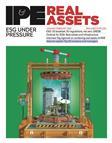Investors should avoid categorising infrastructure by industry sector and “bundling” it with real assets, according to a leading academic.
Frédéric Blanc-Brude, research director at EDHEC-Risk Institute, told IP Real Estate that such practices do not create useful information for asset allocation or benchmarking.
“The emphasis on infrastructure as a ‘real asset’,” he said, “encourages investors to fixate on industrial sectors rather than contractual and financial structures, when the latter explain most of the risk profile and required returns.”
EDHEC-Risk Institute is working alongside industry associations, including the Long-Term Infrastructure Investors Association (LTIIA) to create a series of benchmarks for the asset class.
“So much marketing has been put into the word infrastructure. But from an investment point of view, it is basically meaningless.”
Frédéric Blanc-Brude
EDHEC is also collecting data from investors, partly in response to demand from regulators and partly to help asset allocators and investors assess performance. It has published a paper describing the framework and the data needed to create infrastructure debt and equity investment benchmarks and is building a database, which will include 15 to 20 years of cash flows for at least 1,500 infrastructure investments worldwide by 2016.
Infrastructure tends to be considered high-risk by regulators, a concern for both investors and policymakers seeking to fill the infrastructure funding gap, said Blanc-Brude. Benchmarks are needed because regulators want to understand the risk profile of the asset class, while investors want to use it for liability hedging.
“If we don’t have answers to these questions, it is more difficult to get investment moving,” Blanc-Brude said.
EDHEC and LTIIA argue that benchmarking and risk profiling should be focused on the financial and legal structuring of infrastructure investments, rather than traditional approach of categorising investments by industry sector.
“In the real world, building a bridge is not the same thing as building a power plant,” Blanc-Brude said. “But, from an investment perspective, it may not be the most important difference – and yet people still continue to categorise this information by sector.”
Investments in roads, for instance, can have very different risk profiles, depending on whether they involve toll roads, where income is dependent on traffic, or ‘availability payment’ roads, where income comes from governments.
Blanc-Brude said: “There is more in common between certain projects in the transport sector and the social infrastructure sector in terms of risk profile than two projects in the same sector, which can have completely different structures and completely different risk profiles.”
It can be hard to convey this concept because “so much marketing has been put into the word ‘infrastructure’,” he said. “But from an investment point of view, it is basically meaningless. You really have to ask other questions.
“Infrastructure is not a ‘real asset’, because the special purpose vehicles that you can invest equity or debt in, don’t own anything tangible.
“All they have is a contract with the government, which says you shall build it for 25 or 30 years, and receive a pre-agreed income or have the right to collect a toll calculate to a pre-agreed formula.
“But the asset – the road – remains in the public domain. It is not actually owned by the investors. Even when investors own the tangible asset outright, its value is determined by contracts and regulations.
“This is very different to real estate: a piece of land has intrinsic value – it’s a store of value. Infrastructure is not a store of value. If it cannot be used, it is not worth anything. That is because, in the jargon of economics, infrastructure assets are highly ‘relationships’ specific’.”
For more information on infrastructure investments, look out for IP Real Estate’s Special Issue on the asset class later this month









